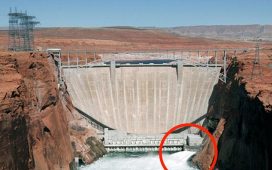Solar minimums mark a period of reduced activity on the Sun every 11 years when sunspots and solar flares are less frequent. During a solar minimum, the Sun’s otherwise violent surface takes on a calmer and almost idyllic appearance. But solar minimums also result in less energy from the Sun being thrown out into space and towards the Earth. And when the Sun entered a solar minimum between 1650 and 1710, NASA said the Earth was plunged into a “deep freeze”.
The US space agency said: “1650 to 1710, temperatures across much of the Northern Hemisphere plunged when the Sun entered a quiet phase now called the Maunder Minimum.
“During this period, very few sunspots appeared on the surface of the Sun, and the overall brightness of the Sun decreased slightly.
“Already in the midst of a colder-than-average period called the Little Ice Age, Europe and North America went into a deep freeze: alpine glaciers extended over valley farmland; sea ice crept south from the Arctic; and the famous canals in the Netherlands froze regularly—an event that is rare today.”
The Sun goes through a cycle every 11 years or so, where it swings from a solar maximum to a solar minimum.
During a solar maximum, sunspots and solar flares spike in intensity, producing warmer temperatures up and down the planet.
During a solar minimum, the opposite is true, with fewer sunspots and longer coronal holes opening in the Sun.
And after the Sun witnessed a high number of sunspots in 2014, NASA said the minimum would strike from 2019 to 2020.
Astronomers typically associate periods of solar minimums with colder temperatures because the “natural heating mechanism” of the Sun subsides.
This mechanism involves ultraviolet radiation from the Sun warming the upper reaches of the Earth’s atmosphere.
READ MORE: Telescope snaps 1,800 incredible supernova eruptions in deep space
NASA said: “But during a solar minimum, this natural hearing subsides.
“Earth’s upper atmosphere cools and, to some degree, can collapse.”
This can have a devastating effect on satellites and space junk, which rely on a heated atmosphere to deorbit and de-clutter space.
During a minimum, NASA said the amount of drag created by objects orbiting Earth drops and “space junk tends to hang around”.
READ MORE: NASA discovers galaxy ‘brimming’ with dark matter
But there are some space weather phenomena, which may grow in strength during a solar minimum.
NASA said these include the increased number of cosmic rays hitting the upper atmosphere – high energy particles whizzing around the galaxy.
Dean Pesnell of NASA’s Goddard Space Flight Center said: “During solar minimum, the sun’s magnetic field weakens and provides less shielding from these cosmic rays.
“This can pose an increased threat to astronauts travelling through space.”














